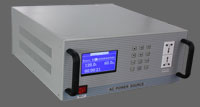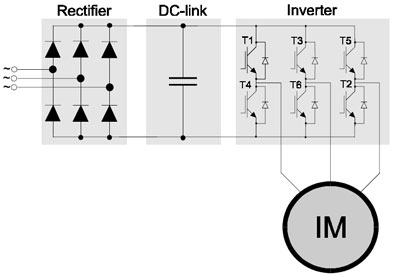Category

Home » Theory
As technology advancing, more and more countries have opted frequency converter as standard power supply. The main reason is that the power can be transformed to achieve the ideal AC power, not only guarantee the security of electricity, but also ensure the effectiveness of electricity. So a lot of frequency converter manufacturers want to get their market share, however, competition among companies is very fierce, how do frequency converter manufacturers stand out in the market?


Frankly we are stuck to our system frequency, say 50Hz in India and Europe vs 60Hz in USA and Canada, We have no choice. However, theoretically a transformer at 60Hz could deliver more power if 20% higher Voltage (as compared to 50Hz) is applied. This would drive the transformer core magnetic loading to the same level as 50Hz at lower voltage; however the eddy and hysteresis losses would be higher, as such I would suggest a 5-10% lower current loading.
We have no choice. However, theoretically a transformer at 60Hz could deliver more power if 20% higher Voltage (as compared to 50Hz) is applied. This would drive the transformer core magnetic loading to the same level as 50Hz at lower voltage; however the eddy and hysteresis losses would be higher, as such I would suggest a 5-10% lower current loading.
Considering the apparent power...isn't it true that if you connect a 50 Hz transformer to a 60 Hz power supply the EMF induced in the second winding will be more than it will be in the case of a 50 Hz supply for the same turns ratio / tapings... now the impedance will be higher but not at the same proportion as increase in EMF because EMF is directly proportional to Hz while increase in frequency will increase inductance but the resistance will remain the same and hence overall impedance will not as high as proportionately to the 10hz ... current drawn will depend on load but with higher imp it will on make transformer hotter while the EMF will be higher... but the overall capability of delivering apparent power will increase ... there can be loads demanding higher reactive power.
 We have no choice. However, theoretically a transformer at 60Hz could deliver more power if 20% higher Voltage (as compared to 50Hz) is applied. This would drive the transformer core magnetic loading to the same level as 50Hz at lower voltage; however the eddy and hysteresis losses would be higher, as such I would suggest a 5-10% lower current loading.
We have no choice. However, theoretically a transformer at 60Hz could deliver more power if 20% higher Voltage (as compared to 50Hz) is applied. This would drive the transformer core magnetic loading to the same level as 50Hz at lower voltage; however the eddy and hysteresis losses would be higher, as such I would suggest a 5-10% lower current loading.Considering the apparent power...isn't it true that if you connect a 50 Hz transformer to a 60 Hz power supply the EMF induced in the second winding will be more than it will be in the case of a 50 Hz supply for the same turns ratio / tapings... now the impedance will be higher but not at the same proportion as increase in EMF because EMF is directly proportional to Hz while increase in frequency will increase inductance but the resistance will remain the same and hence overall impedance will not as high as proportionately to the 10hz ... current drawn will depend on load but with higher imp it will on make transformer hotter while the EMF will be higher... but the overall capability of delivering apparent power will increase ... there can be loads demanding higher reactive power.
Most small 3-phase motors run equally well on 50Hz and 60Hz. In some cases both frequencies are stamped on the nameplates, in other cases you can go into the manufacturer's catalog and choose which frequency you want on the nameplate.
Speed difference: For a standard motor, the RPM is largely proportional to the frequency, so around 20% speed increase at 60Hz compared to 50Hz power supply.
Losses difference: Provided we keep the voltage proportional to the frequency, we will get the same magnetization (flux) at the higher frequency. This will cause a 20-40% increase in the eddy current losses, and around a 20% increase in hysteresis losses in the stator from 50Hz to 60Hz. These losses account generally for only a small fraction of the full load losses, so they can largely be ignored in the comparison. The bearing friction losses will also increase marginally with the increased speed, but they are generally even smaller than the iron core losses just mentioned.
Speed difference: For a standard motor, the RPM is largely proportional to the frequency, so around 20% speed increase at 60Hz compared to 50Hz power supply.
Losses difference: Provided we keep the voltage proportional to the frequency, we will get the same magnetization (flux) at the higher frequency. This will cause a 20-40% increase in the eddy current losses, and around a 20% increase in hysteresis losses in the stator from 50Hz to 60Hz. These losses account generally for only a small fraction of the full load losses, so they can largely be ignored in the comparison. The bearing friction losses will also increase marginally with the increased speed, but they are generally even smaller than the iron core losses just mentioned.
In the recent past, switched mode power supplies that make use of resonant circuits for their operation, have emerged as an alternative to the more conventional types employing pulse width modulation (PWM). Among the important advantages claimed for this class of switched mode power supplies over the PWM type are the following.
- Circuit operation is possible at much higher frequencies, giving scope for reducing the size of reactive components.
- Because of smooth voltage and current waveforms, noise and interference are reduced.
- Stress on the switching devices is also reduced because of smooth voltage and current waveforms; zero voltage and zero current switching is possible.
- Parasitic circuit elements, such as transformer leakage inductance, can be taken into account as part of the circuit itself and so need not affect the circuit performance adversely.
PWM frequency converter controlled AC motors are being used in a big numbers throughout a wide range of industrial applications. The benefits are huge, such as enhanced process control, energy savings, and small inrush currents and torque pulsations during the starting period which gives a longer life for water pumps and applications with motors, better reliability and performance. PWM frequency converter controlled AC motors are usually more reliable than those supplied directly on grid. For instance, the problem of broken rotor bars, mainly due to excessive starting torque, is practically avoided by means of soft starting with a frequency converter.



